Related Research Articles

Matilda of Tuscany, also referred to as la Gran Contessa, was a member of the House of Canossa in the second half of the eleventh century. Matilda was one of the most important governing figures of the Italian Middle Ages. She reigned in a period of constant battles, political intrigues and Roman-Catholic excommunications, and was able to demonstrate an innate and skilled strategic leadership capacity in both military and diplomatic matters.
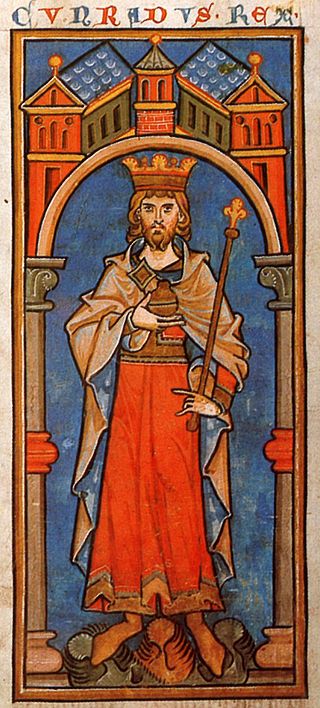
Conrad III of the Hohenstaufen dynasty was from 1116 to 1120 Duke of Franconia, from 1127 to 1135 anti-king of his predecessor Lothair III and from 1138 until his death in 1152 king in the Holy Roman Empire. He was the son of Duke Frederick I of Swabia and Agnes, a daughter of the Salian Emperor Henry IV.

Braunschweig or Brunswick is a city in Lower Saxony, Germany, north of the Harz Mountains at the farthest navigable point of the river Oker, which connects it to the North Sea via the rivers Aller and Weser. In 2016, it had a population of 250,704.
Philip of Swabia was a member of the House of Hohenstaufen and King of Germany from 1198 until his assassination.

The House of Welf is a European dynasty that has included many German and British monarchs from the 11th to 20th century and Emperor Ivan VI of Russia in the 18th century. The originally Franconian family from the Meuse-Moselle area was closely related to the imperial family of the Carolingians.
Frederick V of Hohenstaufen was duke of Swabia from 1167 to his death. He was the eldest son of Frederick I Barbarossa and Beatrice I, Countess of Burgundy.

Welf II, or Welfhard, called Welf the Fat (pinguis), was Duke of Bavaria from 1101 until his death. In the Welf genealogy, he is counted as Welf V.

Henry IX, called the Black, a member of the House of Welf, was Duke of Bavaria from 1120 to 1126.
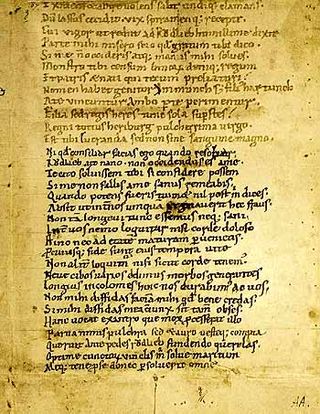
Ruodlieb is a fragmentary romance in Latin verse written by an unknown southern German poet who flourished about 1030. He was almost certainly a monk of the Bavarian Tegernsee Abbey.
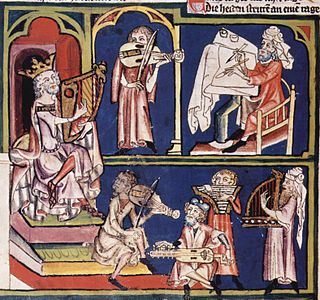
Rudolf von Ems was a Middle High German narrative poet.

Welf III, the last male member of the Swabian line of the Elder House of Welf, was Duke of Carinthia and Margrave of Verona from 1047 until his death.
Adelaide of Vohburg was Duchess of Swabia from 1147 and German queen from 1152 until 1153, as the first wife of the Hohenstaufen king Frederick Barbarossa, the later Holy Roman Emperor.
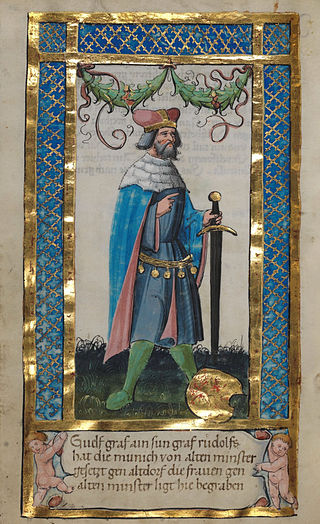
Welf II was a Swabian count and a member of the Elder House of Welf.
Valdemar Knudsen was a Danish clergyman and statesman. Valdemar was Bishop of Schleswig from 1188 to 1208, officiated as Steward of the Duchy of Schleswig between 1184 and 1187, and served as Prince-Archbishop of Bremen from 1192 to 1194 and again between 1206 and 1217. He held the latter office on the grounds of the archdiocesan capitular election as archbishop elect and of the royal investiture with the princely regalia, but lacked the papal confirmation.
Albert II of Brunswick-Wolfenbüttel was Prince-Archbishop of Bremen in the years 1361–1395.
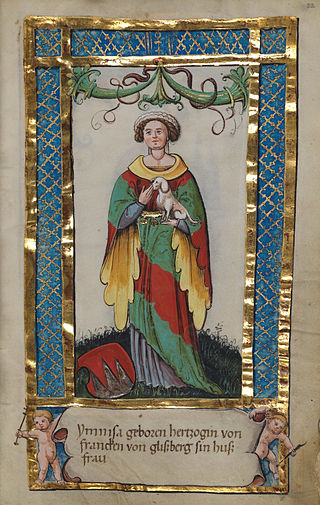
Imiza of Luxembourg, was a German noblewoman. She was the daughter of Frederick of Luxembourg, and the wife of Welf II of Swabia.

Schauenburg Castle is a ruined hilltop castle located in Oberkirch, Germany, atop a 367-metre-high (1,204 ft) (NN) hill spur overlooking the Rench river valley above the town of Gaisbach, Baden-Württemberg. The castle was built by Duke Berthold II of Zähringen.
Burchard of Ursperg, also called Burchard of Biberach (c.1177–1230/1) was a German priest and chronicler. His Ursperger Chronicle is the most important universal history of the late Staufer era.

Gerhard vom Berge or von Berg, also known as Gerhard of Schalksberg, was a member of the vom Berge family, seated at Minden, and until 1397 the holders of the Vogtei rights over the bishopric of Minden. He was precentor and then dean in Minden Cathedral. He became Bishop of Verden from 1363 to 1365 and Bishop of Hildesheim from 1365 to his death on 15 November 1398.

The Historia Welforum is an anonymous Latin prose chronicle of the House of Welf written around 1170. The original covers the period c. 825–1167, but continuations bring it down to 1208. Because two manuscript copies originate in Weingarten (Altdorf), the work is sometimes known as the Historia Welforum Weingartensis or Chronica Altorfensium.
References
- 1 2 Stefan Tebruck (2017), "The Propaganda of Power: Memoria, History, Patronage", in Graham A. Loud; Jochen Schenk (eds.), The Origins of the German Principalities, 1100–1350: Essays by German Historians, Routledge, pp. 160–180, esp. 167–168.
- ↑ John B. Freed (1984), "The Counts of Falkenstein: Noble Self-Consciousness in Twelfth-Century Germany", Transactions of the American Philosophical Society, 74 (6): 1–70.
- ↑ Gerhard Wolf (2016), "Adlige Hauschroniken des Mittelalters und der Frühen Neuzeit", in Gerhard Wolf; Norbert H. Ott (eds.), Handbuch Chroniken des Mittelalters, De Gruyter, pp. 399–445, at 400–401.
- ↑ Ingeborg Neske (1984), Katalog der lateinischen Handschriften der Bayerischen Staatsbibliothek München, Clm 28615a–28786, Otto Harrassowitz, p. 118.